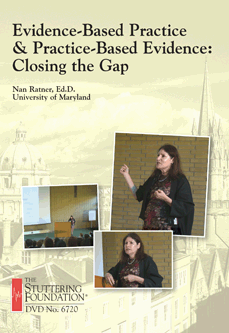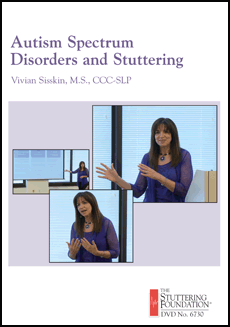Evidence-Based Practice and Practice-Based Evidence: Closing the Gap
 Discussions about evidence-based practice often culminate in claims that there is one best approach to treatment of a particular type of client, or that we lack appropriate evidence or that clinicians lack access to what evidence we have.
Discussions about evidence-based practice often culminate in claims that there is one best approach to treatment of a particular type of client, or that we lack appropriate evidence or that clinicians lack access to what evidence we have.In this presentation, in an effort to frame these claims more positively, Nan Bernstein Ratner, Ed.D., argues that there is both research and common-sense evidence that these claims are wrong. She also suggests that in the debate about best practices in fluency treatment, there is indeed a need to search out and integrate many sources of evidence that either support our approach to a case or suggest a need for reconsideration, adjustment or change.
Many options exist to find and use this evidence, and many more await implementation either in the clinic or in our research undertakings.
This 55-minute talk provides a range of options for both clinical researchers and practicing clinicians who want to find, use and integrate evidence of treatment effectiveness.
Click here to see this DVD in our online store
Autism Spectrum Disorders and Stuttering
 There has been increased interest in understanding the variety of speech disfluency patterns among those with autism spectrum disorders.
There has been increased interest in understanding the variety of speech disfluency patterns among those with autism spectrum disorders.
Case studies that describe types of disfluencies have added to our knowledge base. While both stuttering and “atypical” disfluencies (final part-word repetition) have been documented, many questions remain unanswered. What treatment methods are effective? What are the priorities for improved communication? What should we expect for positive functional outcomes?
In this 2-hour presentation, Vivian Sisskin, M.S., CCC-SLP, from the University of Maryland, summarizes the literature pertaining to disfluency in autism, and provides basic principles to aid in differential diagnosis and treatment planning.
A case study, demonstrating effective treatment for final part-word repetitions, highlights a problem-solving approach to clinical management, using both learning style in autism and strategies from traditional fluency therapies.
Click here to see this DVD in our online store
From the Fall 2012 Newsletter






 Podcast
Podcast Sign Up
Sign Up Virtual Learning
Virtual Learning Online CEUs
Online CEUs Streaming Video Library
Streaming Video Library